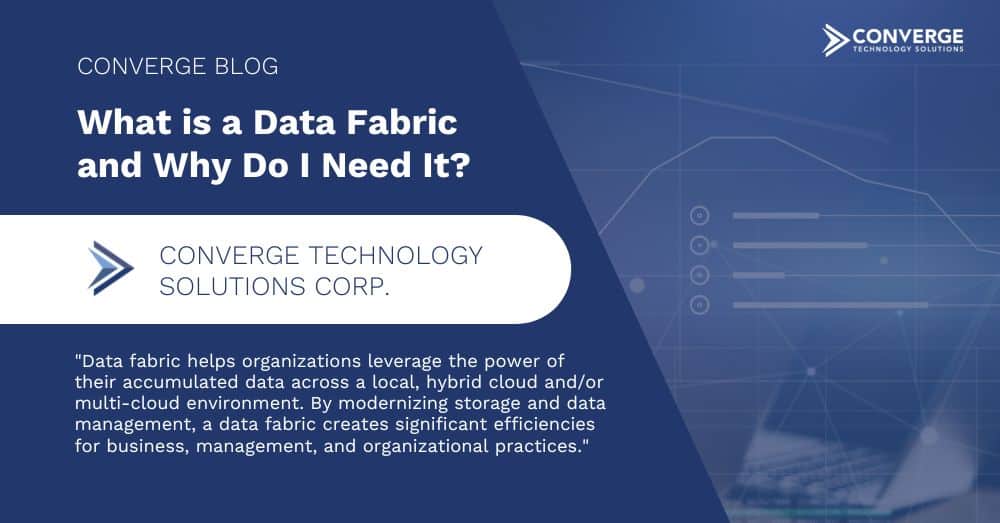Enterprises are producing a staggering amount of data every day. Disparate data sources, lack of access, and complex data integration challenges can prevent organizations from fully utilizing data they collect.
As data continues to grow, these issues compound. A data fabric helps organizations overcome these challenges.
What Is a Data Fabric?
A data fabric is an integrated architecture that leverages data to provide a consistent capability across endpoints spanning a hybrid multi-cloud environment. By creating standardized practices for data management, a data fabric creates greater visibility, access, and control. Most importantly, it creates a consistency that allows data to be used and shared anywhere within your environment.
Data is combined from different sources and types, to create a comprehensive single, virtual source. Regardless of the application, platform, or storage location, a data fabric architecture facilitates frictionless access and data sharing across a distributed infrastructure.
Data fabric architecture simplifies analysis, especially for use with AI and machine learning, and has become a primary tool for many organizations to convert raw data into usable business intelligence. Gartner picked data fabric as its top strategic technology trend for 2022, noting that a data fabric can reduce data management efforts by as much as 70%.
What’s the Difference Between a Data Fabric, Data Warehouse, and Data Lake?
To understand the difference between a data fabric architecture and data warehouses or data lakes, it’s important to understand how data storage has evolved.
Data warehouses are great for storing structured data and providing data in an aggregated, summary form for data analysis. However, it doesn’t work with unstructured data, which represents the majority of data collected. One of the reasons so much data goes unused is that 80% to 90% of the data collected is unstructured and doesn’t adhere to conventional data models.
Data lakes made handling all types of data easier — including both structured and unstructured data —even co-locating data from disparate sources. Data lakes store and maintain replicas of the data, but do not support real-time data and can result in slow response times for some queries. Data lakes can also become a dumping ground for data (a so-called “data swamp”) with data that’s unusable. This can limit effective analysis.
A data fabric overcomes these obstacles by creating unified access to processed data while maintaining localized or distributed storage. This also helps maintain data provenance. It’s not a copy of a data source, but rather a specific data set with a known and accepted state.
A data fabric architecture can work with data warehouses and data lakes as well as any other data sources.
Benefits of Using Data Fabric
Data fabric has three notable benefits, including:
- A unified, self-service data source
- Automated governance and security
- Automated data integration
Unified, Self-Service Data Source
Data fabric pulls together data from disparate sources into one unified source, which makes discovering, processing, and using data easier. It democratizes data by putting it into the hands of users who need it. Based on access policies and controls, data is accessible to anyone authorized for access.
The 2021 Forrester Total Economic Impact, commissioned by IBM, estimates the potential ROI of using a data fabric for a unified, self-service data source at more than 450% providing a benefit to enterprise organizations of $5.8 million.
Automated Data Governance and Security
Localized governance and security can remain in place. This allows you to ensure specific governance and security rules are followed regardless of where the data is accessed. At the same time, you can also create holistic data management policies for governance and security on an enterprise-wide level.
With automated data governance and security rules in place, companies remain in compliance and reduce the risk of data exposure.
Automated Data Integration
By automating (and augmenting) data integration tasks, data scientists and data engineers can significantly reduce manual workloads. Optimized data integration accelerates data delivery and occurs in real-time so data is always in sync.
Why Use Data Fabric?
Data fabric helps organizations leverage the power of their accumulated data across a local, hybrid cloud and/or multi-cloud environment. By modernizing storage and data management, a data fabric creates significant efficiencies for business, management, and organizational practices.
Business Efficiencies
Data is processed quickly and efficiently with automated pipeline management resulting in significant time savings. Automated pipeline management also allows users to gain a real-time, 360-degree view of their data. For example, whether users want to understand their customers or supply chains better, a data fabric provides a holistic view with access to every data point.
Data fabric also create cost-efficiencies by providing a lowered total cost of ownership (TCO) to scale and maintain legacy systems rather than modernizing them incrementally.
Data Management Efficiencies
Data processing, cleaning, transformation, and enrichment is tedious and repetitive. Automating the data preparation removes much of this burden.
A well-designed data fabric architecture also can support significant scale, since data can be stored on-premises, in multi-cloud or hybrid environments. A well designed architecture allows organizations to store data where it is most efficient and cost-effective without sacrificing access.
Organizational Efficiencies
By creating a consistent and common data language allows users to derive greater value. A data fabric creates a semantic abstraction layer that can translate data complexity into easy-to-understand business language. Data is more useful to those without deep data training and experience.
Data Fabric Use Cases
The most common use case for a data fabric is to create a virtual database for centralized business management. Distributed data sources still maintain accessibility for local or regional use while also being accessible by organizations at large. Organizations that have a distributed workforce or regional segmentation often choose this approach while allowing for central access, coordination, and management of data.
Another common use case is when mergers or acquisitions occur. A data fabric strategy can unify disparate sources by bringing the information from the acquired company into the virtual data store without having to replace legacy architecture. While creating unified and harmonized data always requires some level of effort, a data fabric will allow for seamless and centralized data access within and throughout the entire enterprise.
Artificial Intelligence and Machine Learning
AI relies on robust and high-integrity data, but models are only as good as the data that’s algorithms are being fed. A data fabric architecture provides data scientists with the broad and integrative data they need for efficient data delivery. Since so much of machine learning revolves around the logistics of data, a data fabric provides the best solution to manage data complexity.
Implementing a Data Fabric Strategy
As remote work, distributed workforces, and digital business channels continue to grow, it creates a complex and diverse data ecosystem. Add in IoT, sensors, and evolving technology that creates data at a blinding rate, and you can easily create an unmanageable mess of data.
By using a data fabric layer on top of everything, you can overcome these challenges to bring together various data sources across cloud and location boundaries. Implementing a data fabric strategy allows organizations to modernize without having to disrupt or replace legacy systems. You can unify and access your data virtually whether it lives on-prem, in the cloud, or in hybrid or multi-cloud platforms.
Data fabrics provide a holistic view of data, including real-time data, reducing the time required to discover, query, and deploy innovative strategies and providing deeper data analysis that creates better business intelligence.
To learn more about data fabric visit our website for more information on how our team can help you.




